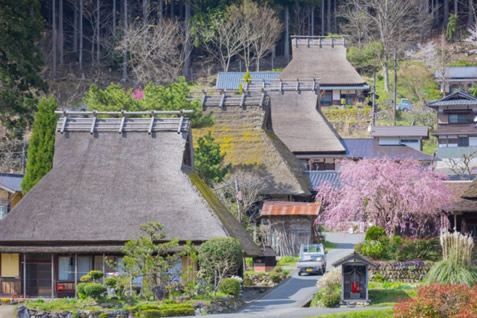Socializing Event (March.28, 2025 only)
Registration Fee is Handled Exclusively by the Travel Agency
【Three Views of Japan: Amanohashidate】
The city of Miyazu, located on Miyazu Bay in the northern part of Kyoto Prefecture, Japan, is home to a unique natural landscape. Due to tectonic plate movements, a sandbar has formed in the sea, which the Japanese refer to as "Amanohashidate of Tango." Along with Itsukushima (formerly known as Aki no Miyajima) and Matsushima of Mutsu, it is collectively known as one of the "Three Views of Japan."
The name "Amanohashidate" is said to originate from a local legend. If one stands at the northern end of the sandbar at Kasamatsu Park or at the southern end at the View Land Observatory, both elevated viewpoints, and looks backward through their legs while facing away from the sandbar, the sandbar appears like a bridge slanting up towards the sky. This is how the place got its name, meaning "Bridge to Heaven."
【Ine Boathouses (Funaya)】
Located in the northeastern part of the Tango Peninsula in northern Kyoto Prefecture, this administrative region primarily relies on fishing and tourism as its main industries. The Tsutsukawa and Honjo-hama areas within the region are said to be the setting of the legend of Urashima Taro. Additionally, the Arai area is believed to be the landing site of Xu Fu, a Chinese alchemist from the Qin Dynasty, who is said to have come to Japan according to legend.
Ine's Funaya (boat houses) are unique traditional buildings native to the area. Funaya first appeared during the mid-Edo period, with local residents constructing two-story buildings along the coast. The first floor is used for mooring boats and boat operations, while the second floor serves as living quarters for fishermen. In 2005, this area was designated as an Important Preservation District for Groups of Traditional Buildings in Japan.
【Miyama Thatched Village】
"Miyama Kayabuki no Sato," along with the Gassho-style village in Shirakawa-go, Gifu Prefecture, and Ouchijuku in Fukushima Prefecture, is known as one of the three major existing thatched-roof settlements in Japan.Currently, there are about 50 buildings in the Kayabuki no Sato Nakamura area, with approximately 40 thatched-roof houses (most of which are residential).
In 1993, this area was designated as an Important Preservation District for Groups of Traditional Buildings in Japan.Compared to the Gassho-style village in Shirakawa-go, "Miyama Kayabuki no Sato" has a lower profile and evokes a sense of seclusion, resembling a magical world. As you gaze across the area, the tranquil and silent village, with its rows of thatched-roof houses, gives the impression of stepping back into Japan's ancient Edo period.
Travel Itinerary
D1
Venue→Three Views of Japan:Amanohashidate ++Ine Boat Tour (Feeding Seabirds)++Miyama Thatched Village++→Venue
【Time Schedule】
| 8:30 | Venue |
| 10:00 | Highway RestArea |
| 11:00 | Amanohashidate |
| 13:00 | Lunch |
| 14:30 | Ine Boat Tour |
| 16:00 | Miyama Thatched Village |
| 18:00 | Venue |
Important Notice:
Rates
| - | Conference delegate: $ 100 USD per person |
| - | Accompanying person: $ 110 USD per person |
| Reservation and Payment Deadline / February20th, 2025 |
Lunch
Entry fees and transportation are covered in your tour registration fee. However, the dinner is not included. If you would like to have meals at your own expense or need suggestions, please discuss with the tour guide.
| * | If there’s any question concerning lunch or dietary restriction (ex: Vegetarian) please email us as soon as possible. |
Attention
| 1. | The schedule and itinerary may be changed due to unpredictable factors such as traffic and weather. |
| 2. | The reservation will be automatically cancelled if no payment is received by February 28th, 2025. |
| 3. | A minimum of 8 people is required to operate a tour. If the minimum is not reached, the tour will be cancelled and a noticed with method of refund will be sent to the registrants from February 28th, 2025. |
| 4. | If participants cancel the reservation for personal reasons, the cancelation charge will be applied as below: From March 5th, 2025: Nonrefundable |
| 5. | If the attraction is invisible due to weather conditions, the tour will not be canceled and fees will not be refunded. |
| 6. | Participants should follow the tour guide’s instructions; HEF and the tour guide are not responsible for participants’ leave without notice and personal activities. |
| 7. | The tour bus will not wait for any personal excuse.If you do not show up on time, the bus won’t wait for you. No refunds will be issued in any case. |









